Report on Infant Visual Perception and Cognition: Psychology Module
VerifiedAdded on 2023/03/30
|6
|1351
|75
Report
AI Summary
This report provides an overview of infant visual perception and cognition from birth to 12 months. It explores the development of various perceptual abilities, including object perception, facial recognition, and auditory perception. The report details the stages of cognitive development, highlighting the sensorimotor stage and the development of reflexes and mental representations. It also examines the role of visual attention, memory, and communication cognition in infants. The report emphasizes the importance of sensory modalities and intermodal perception in coordinating and arranging information. It also provides insights into the development of color vision, object recognition, and facial expression recognition. The report concludes by highlighting the significance of visual perception and cognition in shaping an infant's memory and understanding of the world.
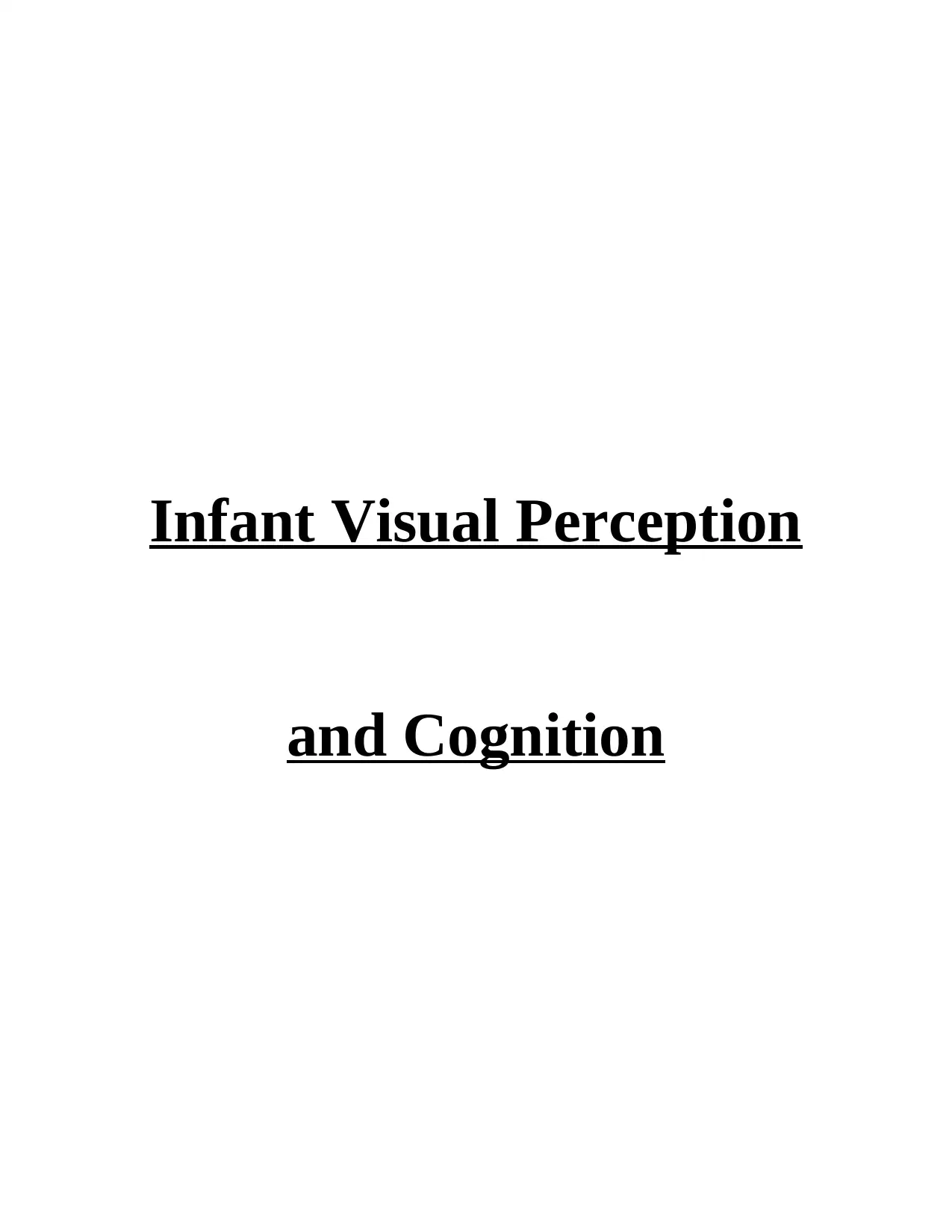
Infant Visual Perception
and Cognition
and Cognition
Paraphrase This Document
Need a fresh take? Get an instant paraphrase of this document with our AI Paraphraser
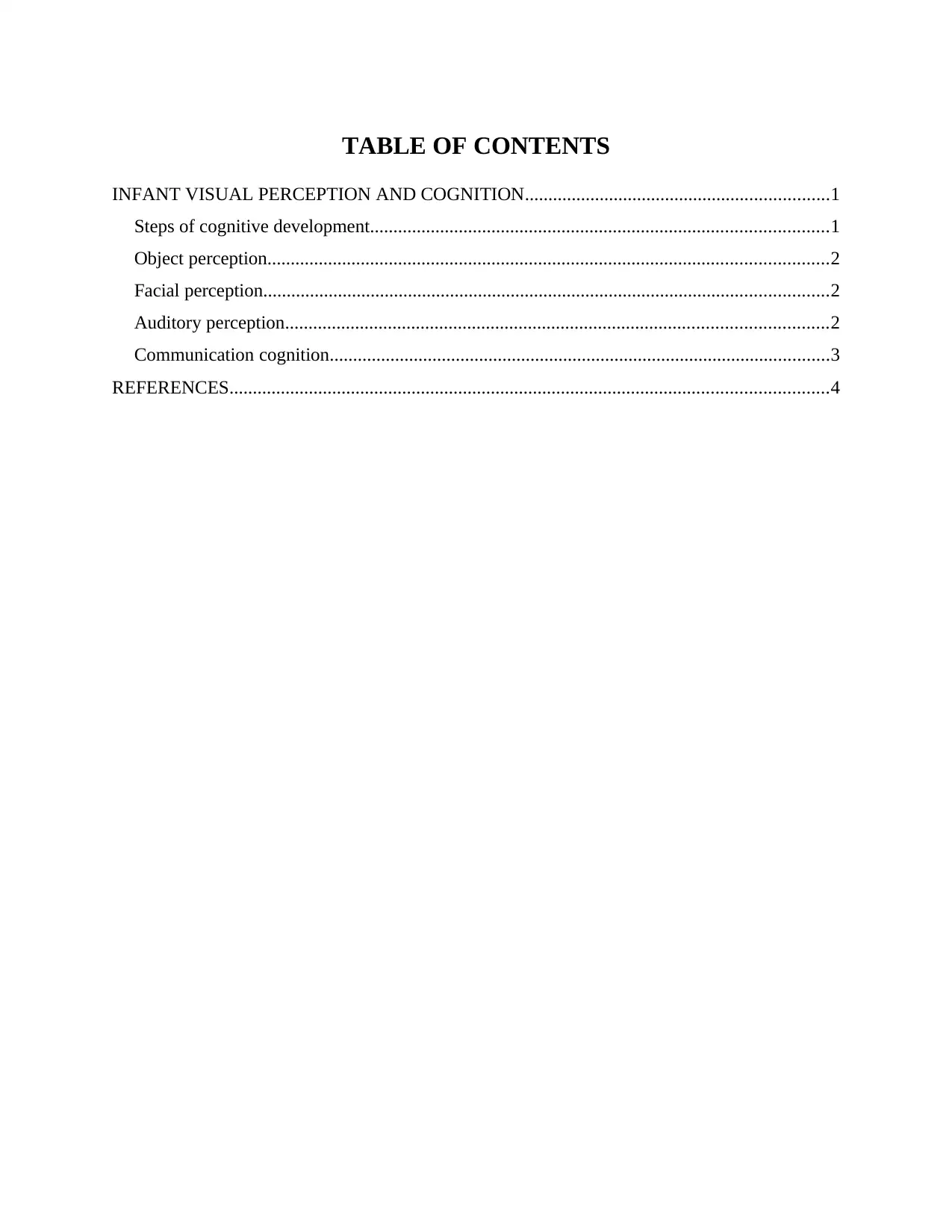
TABLE OF CONTENTS
INFANT VISUAL PERCEPTION AND COGNITION.................................................................1
Steps of cognitive development..................................................................................................1
Object perception........................................................................................................................2
Facial perception.........................................................................................................................2
Auditory perception....................................................................................................................2
Communication cognition...........................................................................................................3
REFERENCES................................................................................................................................4
INFANT VISUAL PERCEPTION AND COGNITION.................................................................1
Steps of cognitive development..................................................................................................1
Object perception........................................................................................................................2
Facial perception.........................................................................................................................2
Auditory perception....................................................................................................................2
Communication cognition...........................................................................................................3
REFERENCES................................................................................................................................4
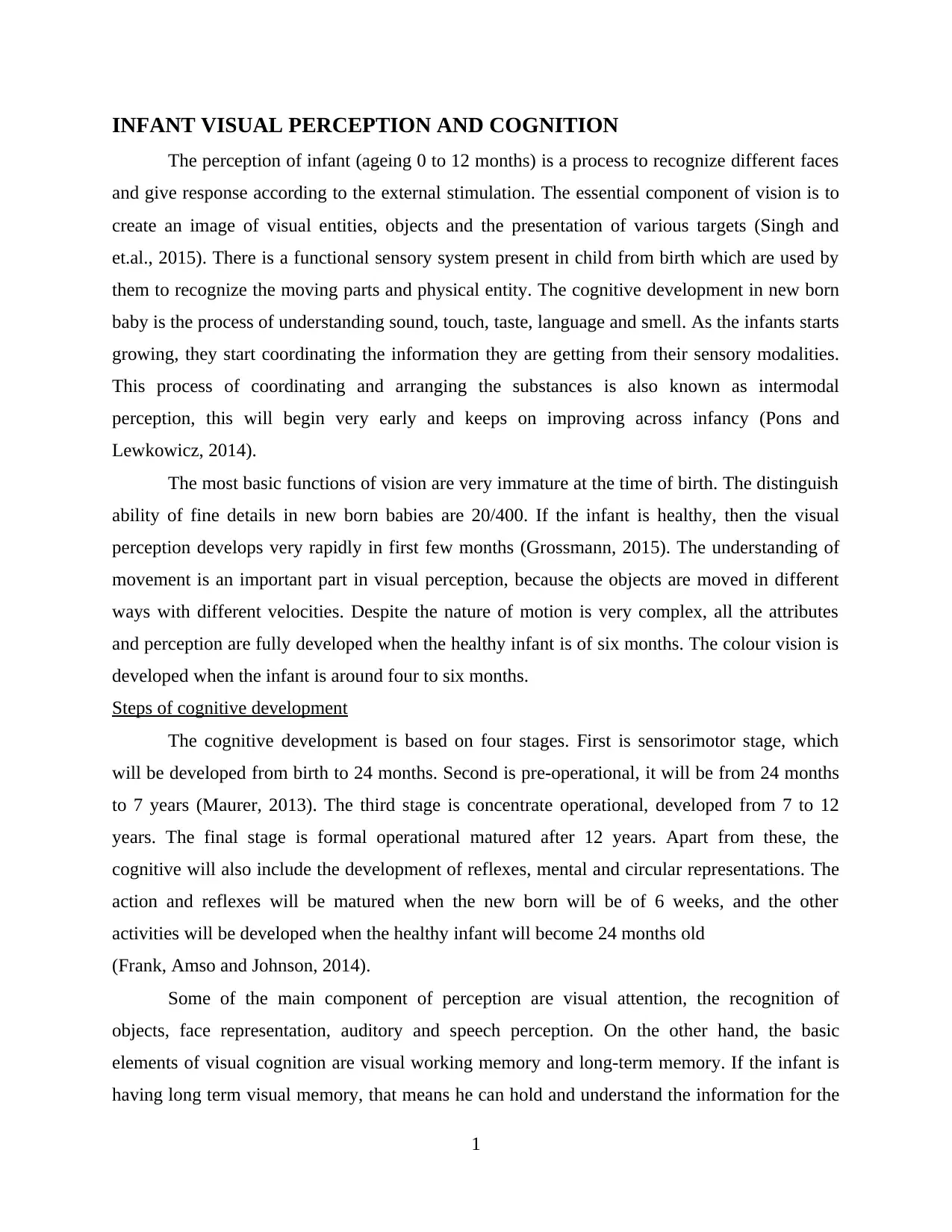
INFANT VISUAL PERCEPTION AND COGNITION
The perception of infant (ageing 0 to 12 months) is a process to recognize different faces
and give response according to the external stimulation. The essential component of vision is to
create an image of visual entities, objects and the presentation of various targets (Singh and
et.al., 2015). There is a functional sensory system present in child from birth which are used by
them to recognize the moving parts and physical entity. The cognitive development in new born
baby is the process of understanding sound, touch, taste, language and smell. As the infants starts
growing, they start coordinating the information they are getting from their sensory modalities.
This process of coordinating and arranging the substances is also known as intermodal
perception, this will begin very early and keeps on improving across infancy (Pons and
Lewkowicz, 2014).
The most basic functions of vision are very immature at the time of birth. The distinguish
ability of fine details in new born babies are 20/400. If the infant is healthy, then the visual
perception develops very rapidly in first few months (Grossmann, 2015). The understanding of
movement is an important part in visual perception, because the objects are moved in different
ways with different velocities. Despite the nature of motion is very complex, all the attributes
and perception are fully developed when the healthy infant is of six months. The colour vision is
developed when the infant is around four to six months.
Steps of cognitive development
The cognitive development is based on four stages. First is sensorimotor stage, which
will be developed from birth to 24 months. Second is pre-operational, it will be from 24 months
to 7 years (Maurer, 2013). The third stage is concentrate operational, developed from 7 to 12
years. The final stage is formal operational matured after 12 years. Apart from these, the
cognitive will also include the development of reflexes, mental and circular representations. The
action and reflexes will be matured when the new born will be of 6 weeks, and the other
activities will be developed when the healthy infant will become 24 months old
(Frank, Amso and Johnson, 2014).
Some of the main component of perception are visual attention, the recognition of
objects, face representation, auditory and speech perception. On the other hand, the basic
elements of visual cognition are visual working memory and long-term memory. If the infant is
having long term visual memory, that means he can hold and understand the information for the
1
The perception of infant (ageing 0 to 12 months) is a process to recognize different faces
and give response according to the external stimulation. The essential component of vision is to
create an image of visual entities, objects and the presentation of various targets (Singh and
et.al., 2015). There is a functional sensory system present in child from birth which are used by
them to recognize the moving parts and physical entity. The cognitive development in new born
baby is the process of understanding sound, touch, taste, language and smell. As the infants starts
growing, they start coordinating the information they are getting from their sensory modalities.
This process of coordinating and arranging the substances is also known as intermodal
perception, this will begin very early and keeps on improving across infancy (Pons and
Lewkowicz, 2014).
The most basic functions of vision are very immature at the time of birth. The distinguish
ability of fine details in new born babies are 20/400. If the infant is healthy, then the visual
perception develops very rapidly in first few months (Grossmann, 2015). The understanding of
movement is an important part in visual perception, because the objects are moved in different
ways with different velocities. Despite the nature of motion is very complex, all the attributes
and perception are fully developed when the healthy infant is of six months. The colour vision is
developed when the infant is around four to six months.
Steps of cognitive development
The cognitive development is based on four stages. First is sensorimotor stage, which
will be developed from birth to 24 months. Second is pre-operational, it will be from 24 months
to 7 years (Maurer, 2013). The third stage is concentrate operational, developed from 7 to 12
years. The final stage is formal operational matured after 12 years. Apart from these, the
cognitive will also include the development of reflexes, mental and circular representations. The
action and reflexes will be matured when the new born will be of 6 weeks, and the other
activities will be developed when the healthy infant will become 24 months old
(Frank, Amso and Johnson, 2014).
Some of the main component of perception are visual attention, the recognition of
objects, face representation, auditory and speech perception. On the other hand, the basic
elements of visual cognition are visual working memory and long-term memory. If the infant is
having long term visual memory, that means he can hold and understand the information for the
1
⊘ This is a preview!⊘
Do you want full access?
Subscribe today to unlock all pages.

Trusted by 1+ million students worldwide
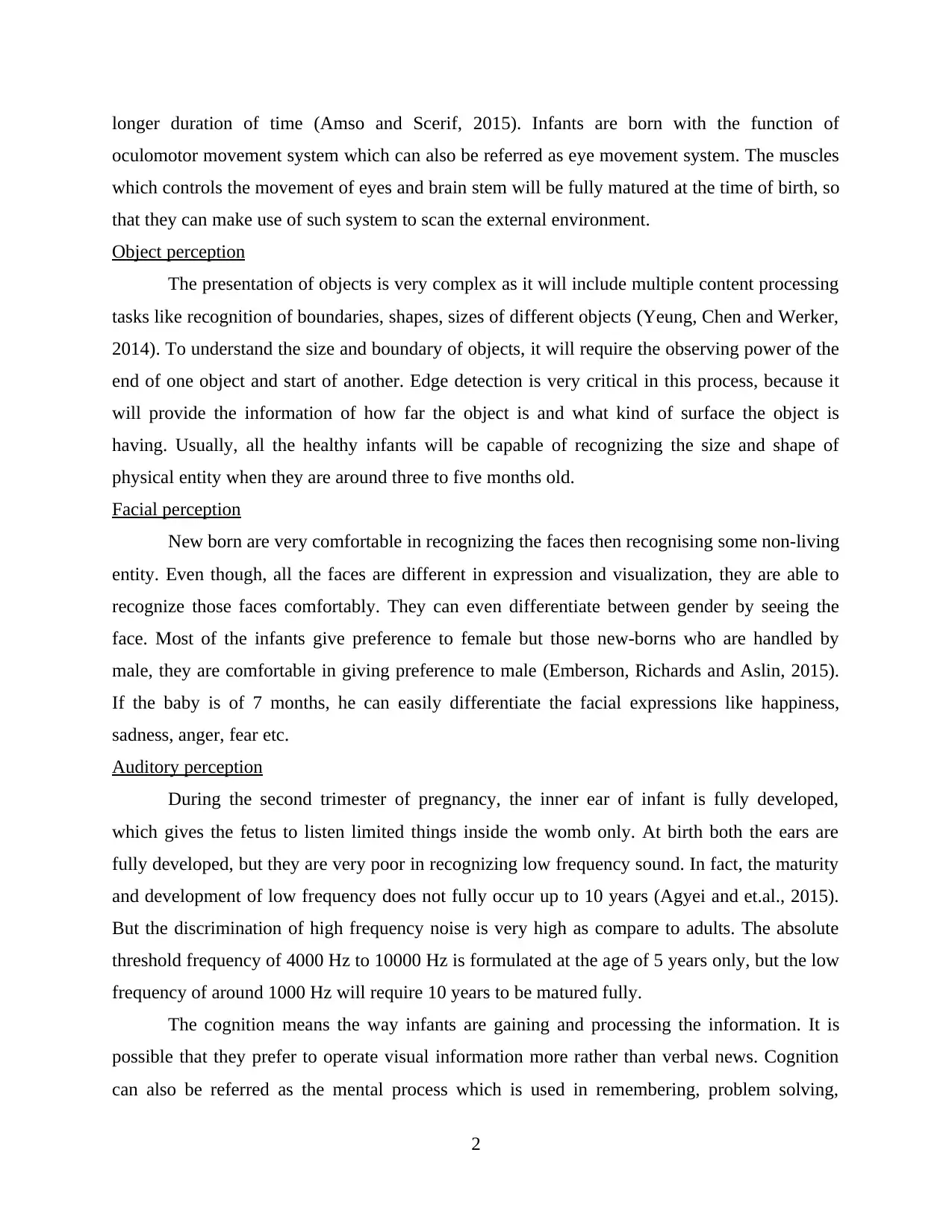
longer duration of time (Amso and Scerif, 2015). Infants are born with the function of
oculomotor movement system which can also be referred as eye movement system. The muscles
which controls the movement of eyes and brain stem will be fully matured at the time of birth, so
that they can make use of such system to scan the external environment.
Object perception
The presentation of objects is very complex as it will include multiple content processing
tasks like recognition of boundaries, shapes, sizes of different objects (Yeung, Chen and Werker,
2014). To understand the size and boundary of objects, it will require the observing power of the
end of one object and start of another. Edge detection is very critical in this process, because it
will provide the information of how far the object is and what kind of surface the object is
having. Usually, all the healthy infants will be capable of recognizing the size and shape of
physical entity when they are around three to five months old.
Facial perception
New born are very comfortable in recognizing the faces then recognising some non-living
entity. Even though, all the faces are different in expression and visualization, they are able to
recognize those faces comfortably. They can even differentiate between gender by seeing the
face. Most of the infants give preference to female but those new-borns who are handled by
male, they are comfortable in giving preference to male (Emberson, Richards and Aslin, 2015).
If the baby is of 7 months, he can easily differentiate the facial expressions like happiness,
sadness, anger, fear etc.
Auditory perception
During the second trimester of pregnancy, the inner ear of infant is fully developed,
which gives the fetus to listen limited things inside the womb only. At birth both the ears are
fully developed, but they are very poor in recognizing low frequency sound. In fact, the maturity
and development of low frequency does not fully occur up to 10 years (Agyei and et.al., 2015).
But the discrimination of high frequency noise is very high as compare to adults. The absolute
threshold frequency of 4000 Hz to 10000 Hz is formulated at the age of 5 years only, but the low
frequency of around 1000 Hz will require 10 years to be matured fully.
The cognition means the way infants are gaining and processing the information. It is
possible that they prefer to operate visual information more rather than verbal news. Cognition
can also be referred as the mental process which is used in remembering, problem solving,
2
oculomotor movement system which can also be referred as eye movement system. The muscles
which controls the movement of eyes and brain stem will be fully matured at the time of birth, so
that they can make use of such system to scan the external environment.
Object perception
The presentation of objects is very complex as it will include multiple content processing
tasks like recognition of boundaries, shapes, sizes of different objects (Yeung, Chen and Werker,
2014). To understand the size and boundary of objects, it will require the observing power of the
end of one object and start of another. Edge detection is very critical in this process, because it
will provide the information of how far the object is and what kind of surface the object is
having. Usually, all the healthy infants will be capable of recognizing the size and shape of
physical entity when they are around three to five months old.
Facial perception
New born are very comfortable in recognizing the faces then recognising some non-living
entity. Even though, all the faces are different in expression and visualization, they are able to
recognize those faces comfortably. They can even differentiate between gender by seeing the
face. Most of the infants give preference to female but those new-borns who are handled by
male, they are comfortable in giving preference to male (Emberson, Richards and Aslin, 2015).
If the baby is of 7 months, he can easily differentiate the facial expressions like happiness,
sadness, anger, fear etc.
Auditory perception
During the second trimester of pregnancy, the inner ear of infant is fully developed,
which gives the fetus to listen limited things inside the womb only. At birth both the ears are
fully developed, but they are very poor in recognizing low frequency sound. In fact, the maturity
and development of low frequency does not fully occur up to 10 years (Agyei and et.al., 2015).
But the discrimination of high frequency noise is very high as compare to adults. The absolute
threshold frequency of 4000 Hz to 10000 Hz is formulated at the age of 5 years only, but the low
frequency of around 1000 Hz will require 10 years to be matured fully.
The cognition means the way infants are gaining and processing the information. It is
possible that they prefer to operate visual information more rather than verbal news. Cognition
can also be referred as the mental process which is used in remembering, problem solving,
2
Paraphrase This Document
Need a fresh take? Get an instant paraphrase of this document with our AI Paraphraser
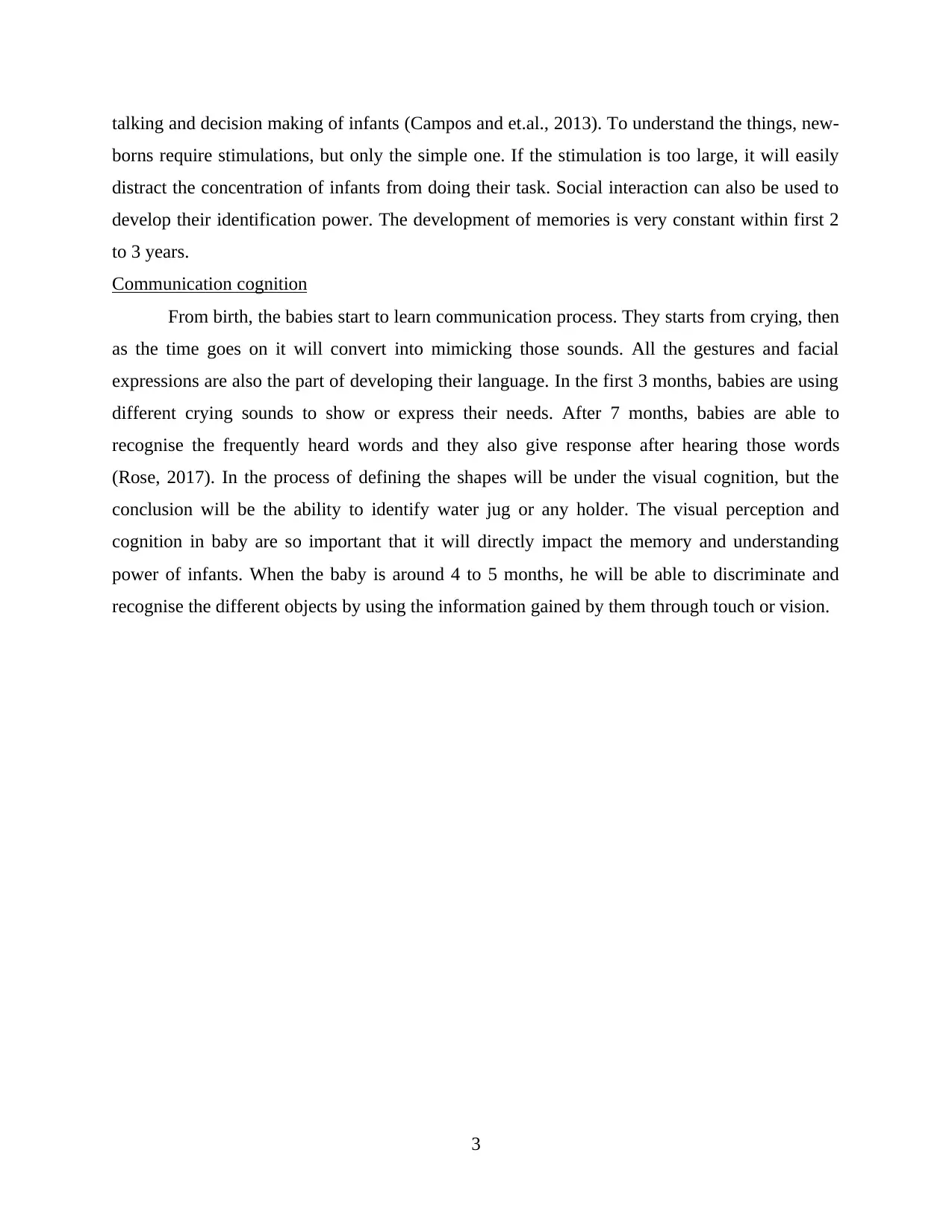
talking and decision making of infants (Campos and et.al., 2013). To understand the things, new-
borns require stimulations, but only the simple one. If the stimulation is too large, it will easily
distract the concentration of infants from doing their task. Social interaction can also be used to
develop their identification power. The development of memories is very constant within first 2
to 3 years.
Communication cognition
From birth, the babies start to learn communication process. They starts from crying, then
as the time goes on it will convert into mimicking those sounds. All the gestures and facial
expressions are also the part of developing their language. In the first 3 months, babies are using
different crying sounds to show or express their needs. After 7 months, babies are able to
recognise the frequently heard words and they also give response after hearing those words
(Rose, 2017). In the process of defining the shapes will be under the visual cognition, but the
conclusion will be the ability to identify water jug or any holder. The visual perception and
cognition in baby are so important that it will directly impact the memory and understanding
power of infants. When the baby is around 4 to 5 months, he will be able to discriminate and
recognise the different objects by using the information gained by them through touch or vision.
3
borns require stimulations, but only the simple one. If the stimulation is too large, it will easily
distract the concentration of infants from doing their task. Social interaction can also be used to
develop their identification power. The development of memories is very constant within first 2
to 3 years.
Communication cognition
From birth, the babies start to learn communication process. They starts from crying, then
as the time goes on it will convert into mimicking those sounds. All the gestures and facial
expressions are also the part of developing their language. In the first 3 months, babies are using
different crying sounds to show or express their needs. After 7 months, babies are able to
recognise the frequently heard words and they also give response after hearing those words
(Rose, 2017). In the process of defining the shapes will be under the visual cognition, but the
conclusion will be the ability to identify water jug or any holder. The visual perception and
cognition in baby are so important that it will directly impact the memory and understanding
power of infants. When the baby is around 4 to 5 months, he will be able to discriminate and
recognise the different objects by using the information gained by them through touch or vision.
3
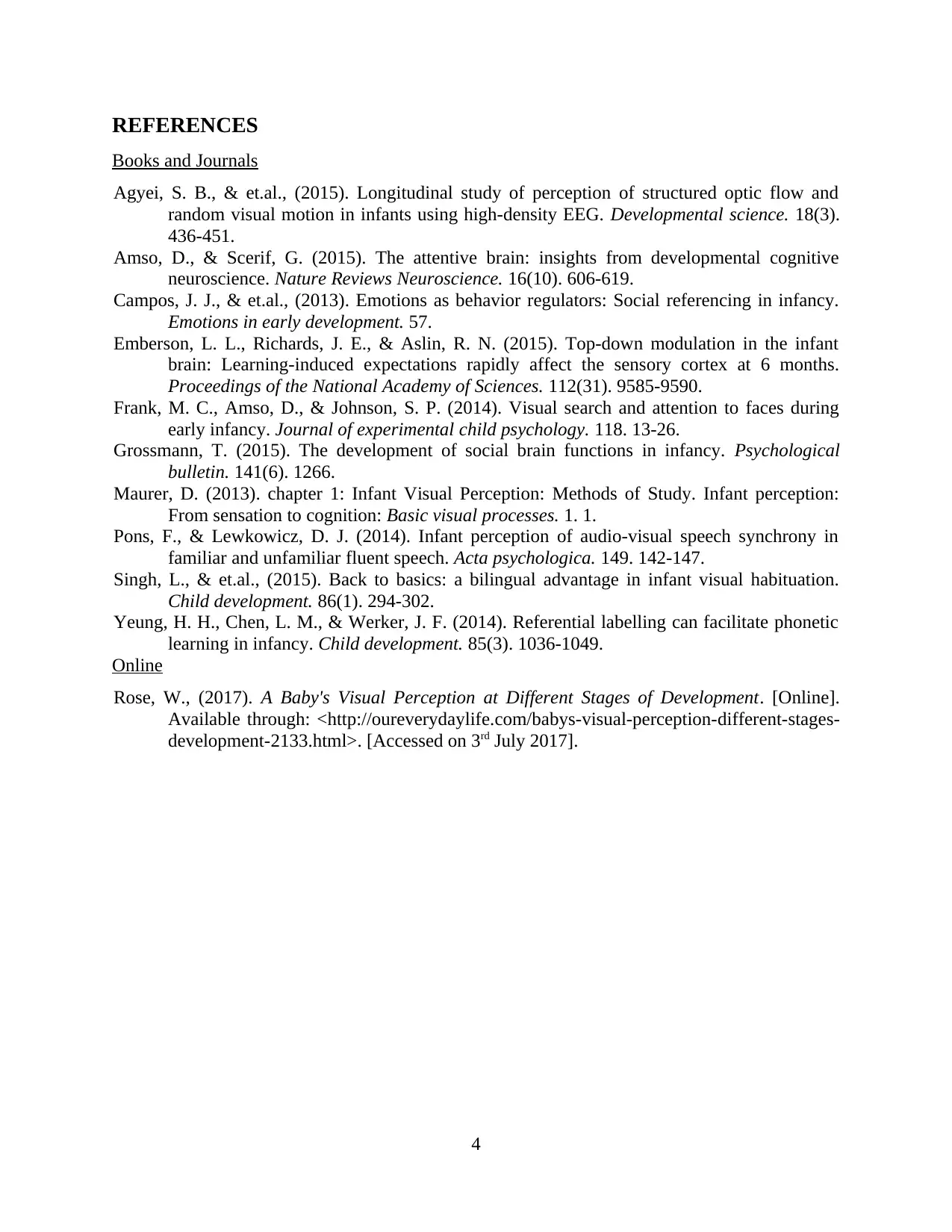
REFERENCES
Books and Journals
Agyei, S. B., & et.al., (2015). Longitudinal study of perception of structured optic flow and
random visual motion in infants using high‐density EEG. Developmental science. 18(3).
436-451.
Amso, D., & Scerif, G. (2015). The attentive brain: insights from developmental cognitive
neuroscience. Nature Reviews Neuroscience. 16(10). 606-619.
Campos, J. J., & et.al., (2013). Emotions as behavior regulators: Social referencing in infancy.
Emotions in early development. 57.
Emberson, L. L., Richards, J. E., & Aslin, R. N. (2015). Top-down modulation in the infant
brain: Learning-induced expectations rapidly affect the sensory cortex at 6 months.
Proceedings of the National Academy of Sciences. 112(31). 9585-9590.
Frank, M. C., Amso, D., & Johnson, S. P. (2014). Visual search and attention to faces during
early infancy. Journal of experimental child psychology. 118. 13-26.
Grossmann, T. (2015). The development of social brain functions in infancy. Psychological
bulletin. 141(6). 1266.
Maurer, D. (2013). chapter 1: Infant Visual Perception: Methods of Study. Infant perception:
From sensation to cognition: Basic visual processes. 1. 1.
Pons, F., & Lewkowicz, D. J. (2014). Infant perception of audio-visual speech synchrony in
familiar and unfamiliar fluent speech. Acta psychologica. 149. 142-147.
Singh, L., & et.al., (2015). Back to basics: a bilingual advantage in infant visual habituation.
Child development. 86(1). 294-302.
Yeung, H. H., Chen, L. M., & Werker, J. F. (2014). Referential labelling can facilitate phonetic
learning in infancy. Child development. 85(3). 1036-1049.
Online
Rose, W., (2017). A Baby's Visual Perception at Different Stages of Development. [Online].
Available through: <http://oureverydaylife.com/babys-visual-perception-different-stages-
development-2133.html>. [Accessed on 3rd July 2017].
4
Books and Journals
Agyei, S. B., & et.al., (2015). Longitudinal study of perception of structured optic flow and
random visual motion in infants using high‐density EEG. Developmental science. 18(3).
436-451.
Amso, D., & Scerif, G. (2015). The attentive brain: insights from developmental cognitive
neuroscience. Nature Reviews Neuroscience. 16(10). 606-619.
Campos, J. J., & et.al., (2013). Emotions as behavior regulators: Social referencing in infancy.
Emotions in early development. 57.
Emberson, L. L., Richards, J. E., & Aslin, R. N. (2015). Top-down modulation in the infant
brain: Learning-induced expectations rapidly affect the sensory cortex at 6 months.
Proceedings of the National Academy of Sciences. 112(31). 9585-9590.
Frank, M. C., Amso, D., & Johnson, S. P. (2014). Visual search and attention to faces during
early infancy. Journal of experimental child psychology. 118. 13-26.
Grossmann, T. (2015). The development of social brain functions in infancy. Psychological
bulletin. 141(6). 1266.
Maurer, D. (2013). chapter 1: Infant Visual Perception: Methods of Study. Infant perception:
From sensation to cognition: Basic visual processes. 1. 1.
Pons, F., & Lewkowicz, D. J. (2014). Infant perception of audio-visual speech synchrony in
familiar and unfamiliar fluent speech. Acta psychologica. 149. 142-147.
Singh, L., & et.al., (2015). Back to basics: a bilingual advantage in infant visual habituation.
Child development. 86(1). 294-302.
Yeung, H. H., Chen, L. M., & Werker, J. F. (2014). Referential labelling can facilitate phonetic
learning in infancy. Child development. 85(3). 1036-1049.
Online
Rose, W., (2017). A Baby's Visual Perception at Different Stages of Development. [Online].
Available through: <http://oureverydaylife.com/babys-visual-perception-different-stages-
development-2133.html>. [Accessed on 3rd July 2017].
4
⊘ This is a preview!⊘
Do you want full access?
Subscribe today to unlock all pages.

Trusted by 1+ million students worldwide
1 out of 6
Related Documents
Your All-in-One AI-Powered Toolkit for Academic Success.
+13062052269
info@desklib.com
Available 24*7 on WhatsApp / Email
![[object Object]](/_next/static/media/star-bottom.7253800d.svg)
Unlock your academic potential
Copyright © 2020–2025 A2Z Services. All Rights Reserved. Developed and managed by ZUCOL.




